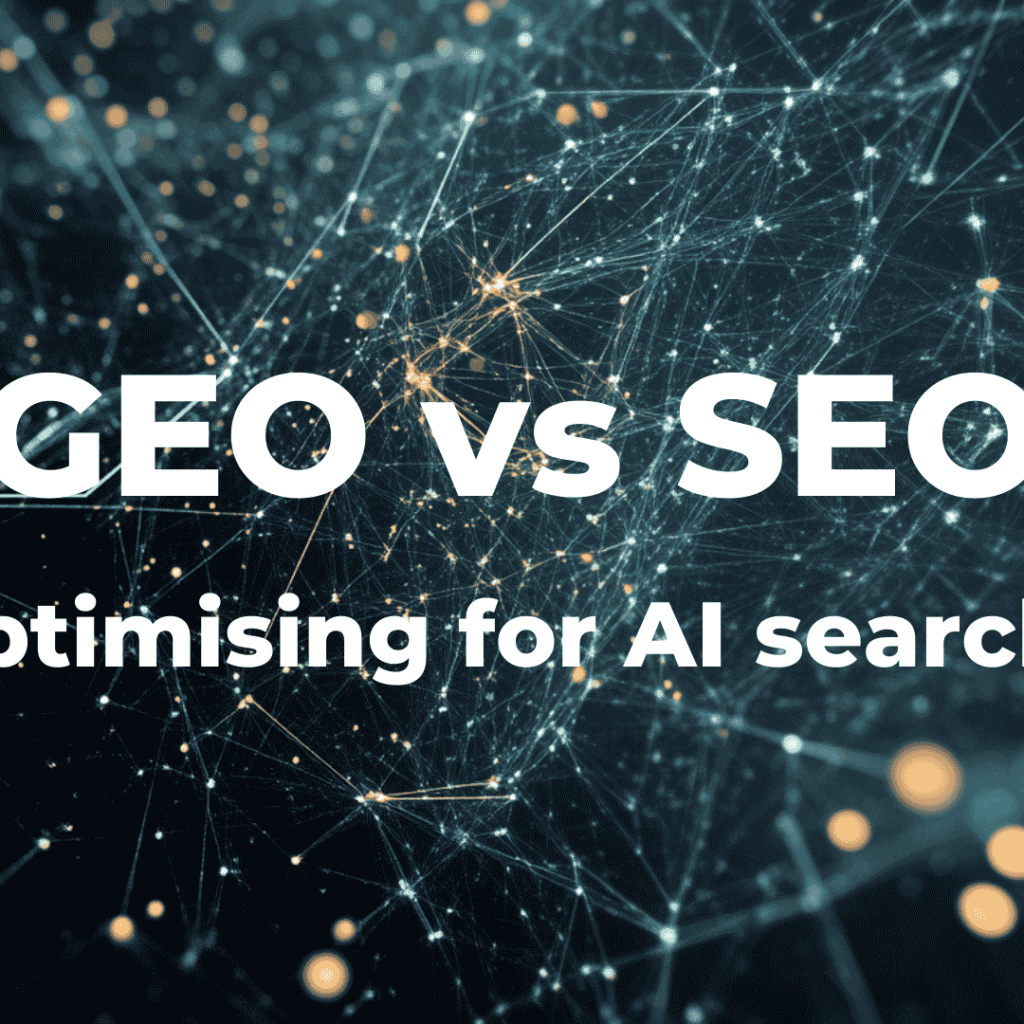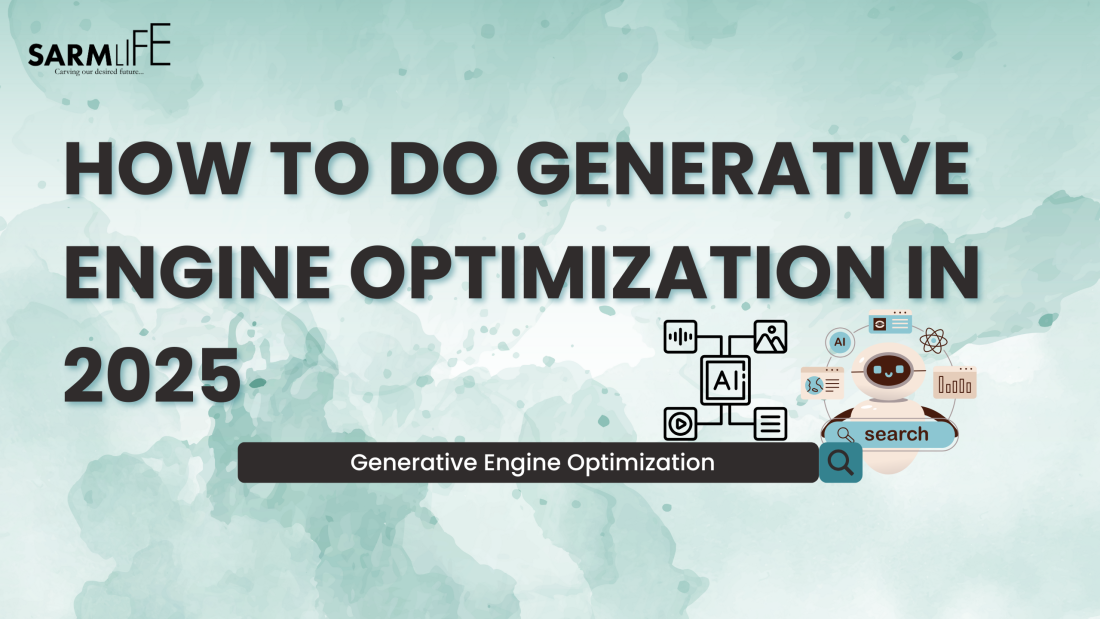Have you noticed that search results are not what they used to be? Instead of just a list of blue links with probable results to guide you on your search, you now see AI-generated summaries giving direct answers at the top of the search pages.
This evolution is evidence that traditional SEO tactics are no longer as effective. To stay ahead in the digital space in 2025 and beyond, businesses and content creators must adopt a new strategy for their search engine optimization: Generative Engine Optimization (GEO).
In this post, we will look at what generative engine optimization is, its working mechanics, and the best strategies to boost your content’s visibility, especially in AI-powered overviews.
RELATED BLOG POSTS
- SEARCH INTENT IN SEO: THE BEST GUIDE TO BETTER CLICKS [2025]
- 7 PRACTICAL TIPS ON HOW TO WRITE SEO HEADLINES IN 2025
- 9 FAIL-PROOF WAYS TO REPURPOSE CONTENT FOR SEO IN 2025
- SARMLIFE SEO TECHNIQUE TO INCREASE WEBSITE TRAFFIC BY 1447.39% IN 10 DAYS
What Is Generative Engine Optimization? And Why It Matters

Photo by Built In
Generative engine optimization, or GEO, is the simple process of optimizing in such a way that AI systems, like Bing Copilot or Google’s AI Overview, can understand, summarize, and display your content in answer boxes or summaries.
Unlike traditional SEO, which ranks webpages based on search engine results pages (SERPs), GEO is focused on being the best possible result within an AI-generated overview.
These summaries are not just from one page. Generative engines engage multiple AI models to collate and synthesize information from numerous high-quality sources.
Therefore, having clear, structured, and authoritative content is the first and most significant step in having your content featured in these AI-generated summaries.
Why GEO Matters Now More Than Ever
Search is becoming more intelligent than ever. AI is gradually replacing direct search results with concise and contextual overviews that provide a better user experience.
Platforms like Bing Copilot, Perplexity.ai, and Google’s AI Overview (formerly SGE) are all restructuring how users engage with content. GEO helps you remain relevant in this rapidly evolving space.
GEO vs. SEO: Key Differences

Photo by Pure SEO
While there are certain similarities between GEO and SEO, their core goals and methods of execution differ. It is, therefore, essential to understand these key concepts to apply the results correctly.
| SEO | GEO |
| Optimizes for rankings in search engine listings | Optimizes for inclusion in AI-generated summaries |
| Focuses on backlinks, keywords, and meta descriptions | Focuses on structure, clarity, and intent-based content |
| Prioritizes page optimization for bots | Prioritizes natural language and E-E-A-T for AI comprehension |
| Competes for space in the blue link rankings | Competes for space in AI response summaries |
AI Overviews will not only scan your title but also break down your headers, edit your formatting, and analyze how quickly and clearly your content answers user queries. SEO is impressive; however, GEO emphasizes intent-driven, structured, and conversational content.
How to Create GEO-Friendly Content
If you need your website content or blog post to be featured in generative answers, these are the steps to follow:
1. Write clear, concise answers.
This strategy is the first step to making your content visible in generative answers. Use simple language that is direct and straight to the point. AI will always prefer clarity over fluff. Let your answer to the main query begin in the first 1-2 sentences.
2. Implement structured formatting.
Structured formatting is essential in generative engine optimization. AI models thrive on structured formatting. To ensure your content is appropriately formatted, use:
- H1 for your main topic
- H2s and H3s to organize subtopics
- Bullet points and numbered lists
- FAQs at the end
Structure helps AI segment and parse your content very quickly, allowing you to incorporate it into the summaries.
3. Prioritize E-E-A-T.
The E-E-A-T strategy is essential for generative engine optimization. It stands for Experience, Expertise, Authoritativeness, and Trustworthiness. Include author bios, cite very reputable sources, and showcase your credibility within your niche.
4. Target long-tail keywords & natural language.
Long-tail keywords are ideal because they are similar to what the user will input in their search. Questions like “What is generative engine optimization GEO?” or “How to do generative engine optimization?” are ideal. Ensure you make use of conversational, user-focused phrasing.
Also, ensure you use a conversational yet authoritative writing style. Use proper transitions, connect your ideas as clearly as possible, and always have your audience’s intent in mind.
Don’t ever ignore mobile optimization. So many AI-generated overviews are served on mobile-first environments. As a result, ensure your site is clean, fast-loading, and mobile-responsive, as this makes any GEO content more accessible and trustworthy.
Actionable GEO Content Template

Photo by SiteGround
Now that you know how to create GEO content, here’s a simple framework that is structured using generative engine optimization best practices:
- Title: Ensure you add your primary keyword (e.g., “How To Do Generative Engine Optimization in 2025”)
- H1: What is [Keyword] and Why It Matters
- Brief intro with a 1-2 sentence answer
- H2s: Break down subtopics such as:
- How does it compare to SEO?
- Key strategies to implement
- Tools to support your content
- Real-life examples or use cases
- FAQ Section: Include 3-4 user-centric questions using natural language.
- Schema Markup: Use the FAQ schema and Article schema so that search engines and AIs can pull your data.
Suppose you’re writing a post about “Remote Work Tools in 2025.” Your GEO-aligned structure could follow this pattern:
- H1: What Are the Best Remote Work Tools in 2025?
- Introduction: A 2-sentence summary answering the question.
- H2: How These Tools Increase Productivity
- H2: Features to Look for
- H2: Top 5 Tools Reviewed (use bullet points or tables)
- H2: Expert Tips for Choosing the Right Tool
- H2: FAQs about Remote Work Tools
Incorporating examples like this demonstrates how to structure content and how to anticipate what AI may extract when summarizing results.
Fundamental Strategies for GEO from SARMLife

Photo by SmartBug Media
At SARMLife, we’ve adjusted to the search evolution by helping clients all over the world fine-tune their content for AI readability.
- Transitioning Clients from SEO to GEO
We arrange and audit existing content to explore and determine which pieces are easily extractable by AI. After that, we restructure these articles using the GEO framework and templates.
- Tailored Content Writing Services
Our team specializes in curating and crafting answer-first blog posts, landing pages, and FAQs that align with the structural and contextual needs of AI-powered tools.
- Website Optimization for AI Discoverability
At SARMLife, we don’t just write. We optimize. From schema markup to page layout, every piece is designed with machine comprehension in mind.
Our approach at SARMLife isn’t just about writing content; it’s about future-proofing your digital voice.
We start by mapping your content inventory against likely AI prompts and user queries. Then, we create content clusters and topical maps that ensure your authority in a given niche.
Whether you’re a SaaS company, a coaching brand, or a finance blog, we develop a GEO strategy unique to your business goals.
Final Thoughts: Embrace GEO to Stay Ahead

Photo by Keitaro Blog
AI-generated summaries can be the best thing for your website in 2025 if you can implement the key generative engine optimization (GEO) strategies in this post.
As a blogger, brand, or business owner, integrating generative engine optimization today ensures your visibility tomorrow.
Remember, the rules of digital engagement have changed. Visibility is no longer only about being in the top three blue links. It’s about becoming a part of the conversation happening between AI and your audience. And GEO is your way into that room.
Save this post, share it with your team, and start rewriting your content strategy with GEO in mind.
FAQs about GEO
What is generative engine optimization (GEO)?
Generative engine optimization (GEO) is the simple process of optimizing in such a way that AI systems, like Bing Copilot or Google’s AI Overview, can understand, summarize, and display your content in answer boxes or summaries.
How does GEO affect my content strategy?
It shifts your focus from just keyword rankings to quality and content structure. GEO makes you write better, clearer, and more structured content.
What kind of content ranks best in AI summaries?
Well-structured content directly answers questions and demonstrates authority—for example, how-tos, definitions, FAQs, and expert breakdowns.
Can SARMLife help me improve my content visibility in AI results?
Yes! SARMLife offers customized content writing and optimization services specifically designed to help your content stand out in generative search tools.
Subscribe to our newsletter to get more tips on mastering GEO and AI-driven content.
READ MORE: THE IMPACT OF AI IN SEO | THE FUTURE OF SEARCH ENGINE OPTIMIZATION


Add a Comment